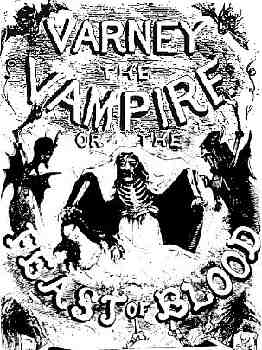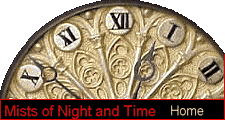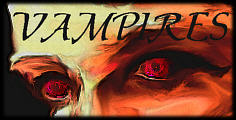Vampir -- Also vampyr, generally the European spelling for "vampire". English cleric, Gothic scholar and student of the occult Montague Summers (1880-1947) traced the word back to Magyar (Hungarian) via Slavonic origin, appearing in many lands such as Russia, Poland, Hungary, Serbia, Bulgaria, and Czechoslovakia -- anywhere there has been a Slavic influence. The term spread so that vampyr is found in most European countries.
The many, varied species of vampires, and all theories about their place of origin have their preferred cradles, be it Egypt, Mesopotamia, India, China or Russia, with Romania (or Transylvania) being considered strictly because of |Bram Stoker's Dracula|, an 1897 novel reflecting the age of Victorian repression more than ancient origins.
Religious and divine or semidivine bloodsuckers were important to ancient cults, becoming potent elements in formative religions. After all, some Christian religions incorporated the idea of drinking blood. Catholics "eat the body and drink the blood" of Christ symbolically, with wafers and wine substituting for body and blood.
Life and death, blood and earth were inextricably linked in both the old and new worlds of human civilization and superstition. The earth was part of life and death, of course, providing crops but also providing a "final resting place". But some of the dead failed to rest, emerging from the earth to plague the living in most cases (a rare few vampires were harmless. An even smaller group actually wanted to help their loved ones, like a deceased cobbler who came back to finish shoes for his son overnight). Unnatural as this return seemed, the vampire was often limited by natural forces such as sun, water and fire. But it could control parts of nature, such as rain, clouds and many types of animals -- wolves, bats and rats being the favored species.
For centuries, peasants as well as church leaders were dominated by fears and superstitions regarding vampires. Many "learned" men practiced a sort of pseudoscience, bound up in rigid theology and folk beliefs, but the earliest beliefs originated with country people and gypsies.
THE ROMANTIC VAMPIRE
The transition from a vampire of old folklore to romanticism can be exemplified by a book from the 1800's, one which notably first mentioned fangs in literature, and also introduced the stake as part of the vampire hunter's arsenal.
"Varney the Vampire: Or the Feast of Blood" first appeared in 1840 in "penny dreadfuls", the 19th century version of soap operas or cliffhanger serials. Intended for the working class to buy at a penny an issue, they were published in eight-page installments per week, and story continuity depended only on how popular the work was.
This story spun out to 108 or 109 episodes. While there has been debate about who penned the work, which was published anonymously at first, Malcolm James Rymer has been given credit as the author. Still, some think the writer is Thomas Preskett Prest, who wrote "Sweeney Todd, the Demon Barber of Fleet Street", among other works during a prolific career. And others believe that the serial was written by several authors during the two year period of its great popularity.
 All the installments were gathered into a novel in 1847, coincidentally the year |Bram Stoker| was born.
All the installments were gathered into a novel in 1847, coincidentally the year |Bram Stoker| was born.
The story is about Sir Francis Varney, who is cursed with vampirism as punishment for killing his own son.
Here is a paragraph describing his face and how he feeds:
"It is perfectly white -- perfectly bloodless. The eyes look like polished tin; the lips are drawn back, and the principal feature next to those dreadful eyes is the teeth -- the fearful looking teeth -- projecting like those of some wild animal, hideously, glaringly white, and fang-like. It approaches the bed with a strange, gliding movement. It clashes together the long nails that literally appear to hang from the finger ends. . . . He drags her head to the bed's edge. He forces it back by the long hair still entwined in his grasp. With a plunge he seizes her neck in his fang-like teeth -- a gush of blood, and a hideous sucking noise follows. The girl has swooned, and the vampyre is at his hideous repast!"
The amassed book is over 800 pages long, and has several rambling passages which loose the thread of its own plot, making it difficult to read. Other parts of the work are good melodrama, and extracts have appeared in vampire anthologies ever since "Varney" was published.
+ + +
Thus the Romantic movement in the 1800's adopted an essentially primitive and rural belief, unearthing the vampire from its rough habitats so it could prey on "polite" society. As if there weren't enough intellectual and political bloodsuckers already, or perhaps because there were too many, the vampire has adapted endless times to fit the needs of changing generations. Moving from farm to city, vampires have also moved from undesirable to darkly compelling.
"Where once the vampire was the corporeal embodiment of satanic activity in the world, today it is the reflection of the contemporary society's morbid preoccupations with aging and death. The undead serve as cultural metaphors of elusive immortality and victory over life. The vampire has achieved eternal life without the attainment of spiritual perfection or salvation. Here are beings who have conquered death, who have turned the tables on the suffering of daily living, and who have come to function outside the boundaries of society. For them actions have no moral limitations imposed from without, and there is no personal responsibility for deeds, regardless of how objectionable. They are sensual, irresistible, and immune to the horrifying aspects of the twentieth century: violence, drugs, AIDS, disease, famine, and financial and social chaos. Being a vampire signifies membership in this most select body of beings the world has ever known. . ."
Matthew Bunsun
The Vampire Encyclopedia (1993)
| Early Types of Vampires | European Vampires | Eastern Vampires |
|Vampires Then and Now|
|In a Welcoming Vein: Vampire Renaissance map|
+ + +
|The Entrance Gate|



07.03.03
Most graphics created or adapted by Dracowylde
Vampires Then and Now

![]()
 All the installments were gathered into a novel in 1847, coincidentally the year
All the installments were gathered into a novel in 1847, coincidentally the year 

